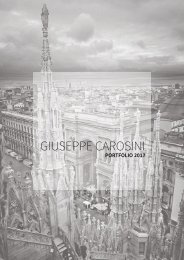You also want an ePaper? Increase the reach of your titles
YUMPU automatically turns print PDFs into web optimized ePapers that Google loves.
STRUCTURE<br />
Once the possibility of free unimpeded movement is at the basis<br />
of everything it is part of the ludic nature of people, born out of the<br />
primitive being within us to construct. Embracing this primordial urge,<br />
this creativity is made manifest. This occurrence is not unprecedented<br />
and can be seen when delving deeper into the outputs of refugees<br />
within this current crisis. Syrian refugees within the Zaatari refugee<br />
camp have put this ludic tendency to work through the construction of<br />
elaborate fountains within their ‘temporary’ living environment. As an<br />
important part of their culture, these have been adorned with a plethora<br />
of objects even going as far as in-casing within them flat screen<br />
TV’s. Other forms of creative expression in similar circumstances can<br />
be seen to such as the expansion of structures within caravans in gypsy<br />
camps, where the temporary is expanded, adapted and improved<br />
upon in order to satiate the needs of its inhabitants.<br />
Dover Church<br />
Thus structure is born.<br />
The structure holds the space in which refugees can move freely, its<br />
permeable sides allowing the flow of people and landscape through<br />
it and within it. This demarcation of this safe zone becomes a visual<br />
symbol in the landscape, working to identify itself as a visual beacon,<br />
distinguishable and providing hope even from a distance. Built along<br />
the existing railway, the structure can be assembled, upgraded and<br />
dismantled as needed.<br />
The processional emotion generated by the structure is akin to the<br />
nave of a church, guiding its occupants through it triggering movement.<br />
The structure allows for space itself to become pliable, taking<br />
the simplest form in order to allow for the flexibility to accommodate<br />
the most complex of functions. The space internally is forever changing,<br />
functions fluctuating functions from day to night.<br />
Basilica of Maxentius<br />
141 LIFE IN MOTION<br />
Old Saint Peters Basilica<br />
The Axis of Procession<br />
The concept of the church / basilica layout :<br />
the nave is architecturally shaped for procession,<br />
movement towards salvation (altar...)<br />
; the priority in the spatial organization is<br />
clear - the aisles are supporting spaces for<br />
what happens in the middle. The early types<br />
of basilica do not even contain the aisles, but<br />
the Nave is always there.




